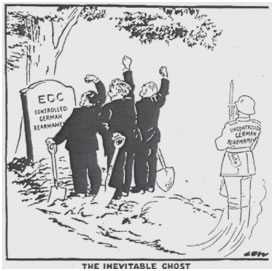Democrat March-April 2010
Route to the European Constitution
Brusssels Treaty
Part 2. European Defence Community and the Western European Union

Following the Second World War (WWII) a mutual assistance military pact was signed in 1948 between Britain, France, Belgium, Luxembourg and the Netherlands. This was the Brussels Treaty. The following year the North Atlantic Treaty Organisation (NATO) was formed under the Washington Treaty. This Treaty included a secret agreement where Britain was to retain Northern Ireland as part of the United Kingdom to protect the western flank of Europe from any Soviet threat. NATO membership included the original Brussels Treaty states, USA, Canada, Portugal, Italy, Norway, Denmark and Iceland. Initially NATO was political collaboration rather than a military pact.
Cartoon by David Low in the Manchester Guardian (23.6.54) depictimg Aneuran Bevan opposing the EDC and rearmament of Germany. The Wehrmacht soldier has NATO tucked into his belt!
Around this time as one of the WWII allies the USSR which Winston Churchill said had “torn the guts out of the Nazi war machine” applied to join NATO and was turned down. This raised Soviet fears about the real intentions behind the USA led NATO.
A European Defence Community (EDC) was proposed by French political leaders in 1950 both as a reaction to NATO and the next logical step to follow the European Coal and Steel Community (see August September 2009 Democrat). The EDC Treaty was signed on 25 May 1952 and immediately ran into controversy. The Labour government at that time was divided over this question and would not take part because it did not want supranational powers given to the EDC.
The Atlee Government objected to the EDC and the parallel aim of German rearmament. Demonstrations took place in Parliament Square.
In France deputies and political parties were divided. Both Gaullists and Communists were opposed to the EDC and the upshot was that the French National Assembly rejected ratification of the Treaty in August 1954.
Soon after on 23 October the Western European Union (WEU) was formed with the Paris accords which amended the Treaty of Brussels. The WEU structure included an Assembly, Arms Control Agency and a Standing Committee for Arms Control. This military institution was a political step which enabled Italy and West Germany to join the WEU and opened up the authorisation of West Germany’s rearmament. In 1955 on 5 May West Germany joined NATO despite widespread opposition and huge objections from the USSR.
On 14 May the Warsaw Pact was formed as it was clear that NATO was lined up against the east and central European socialist countries. The Warsaw pact consisted of an alliance of the USSR, Poland, Czechoslovakia, GDR, Romania, Bulgaria, Albania and Hungary. The latter countries had been liberated from Nazi occupation by the Red Army aided by partisans and other resistance.
The objective of those who initiated the ECSC to have through EDC a European Army was not achieved. This was partly due to the USA which had not been in favour of an EDC. Instead, NATO dominated this military arena with bases and occupation forces all around Western and Southern Europe facing the guns and missiles eastwards. This was an integral part of the so-called Cold War.
The Gaullists were mindful of France’s right to self-determination and set out to develop her own nuclear weapons independent of the USA. After several stages of withdrawing forces from NATO involvement, France left the command structure of NATO in 1966.
The WEU remained in existence and was used to advance the Euro-federalists objectives of “European integration” and a European Army. The WEU brought together member states in concerted military campaigns of some Common Market members.
From around 1955 the WEU in the main remained moribund as a political device to be dusted down and activated when required. This was done just prior to the Single European Act of 1986 which will be dealt with later in this series.
See other parts in this series:
Part 1. Paris Treaty - European Coal and Steel Community
Part 3. Quest for a US of Europe - The role of the USA, CIA and Winston Churchill